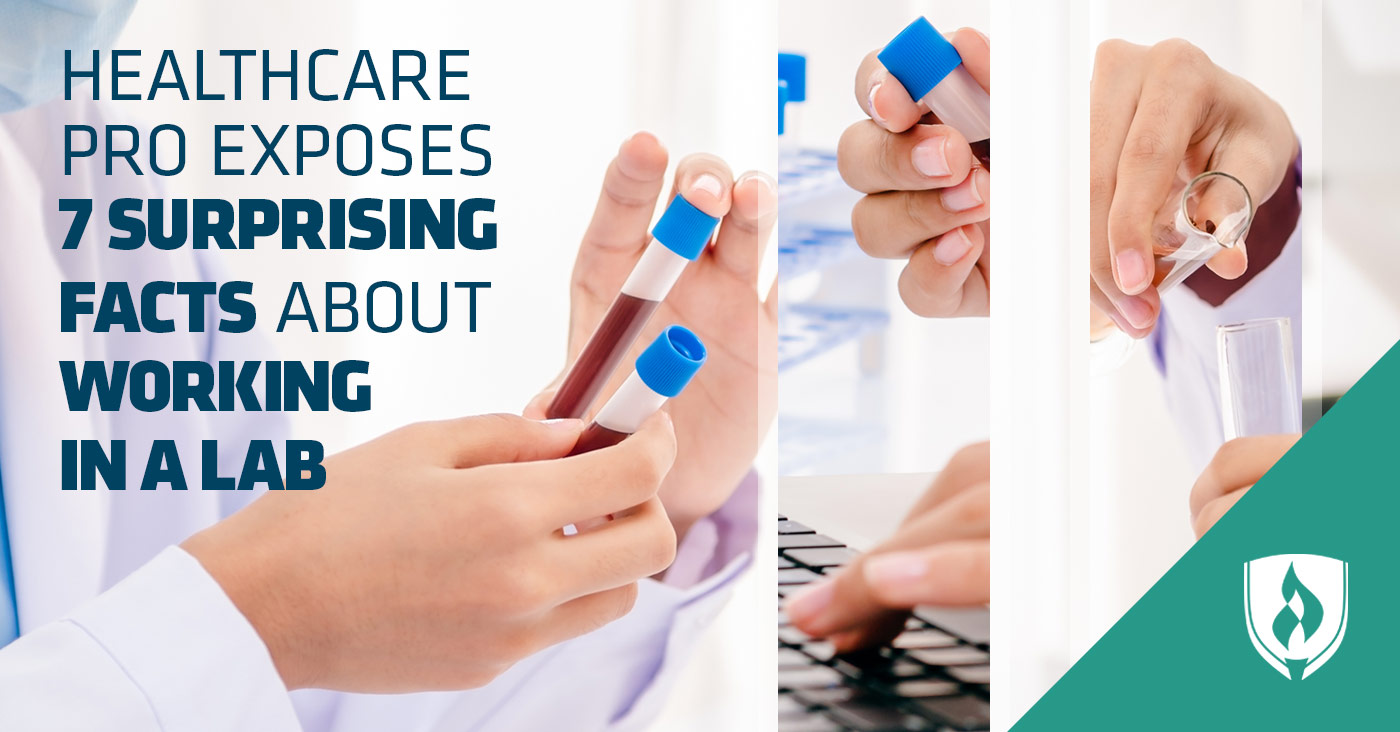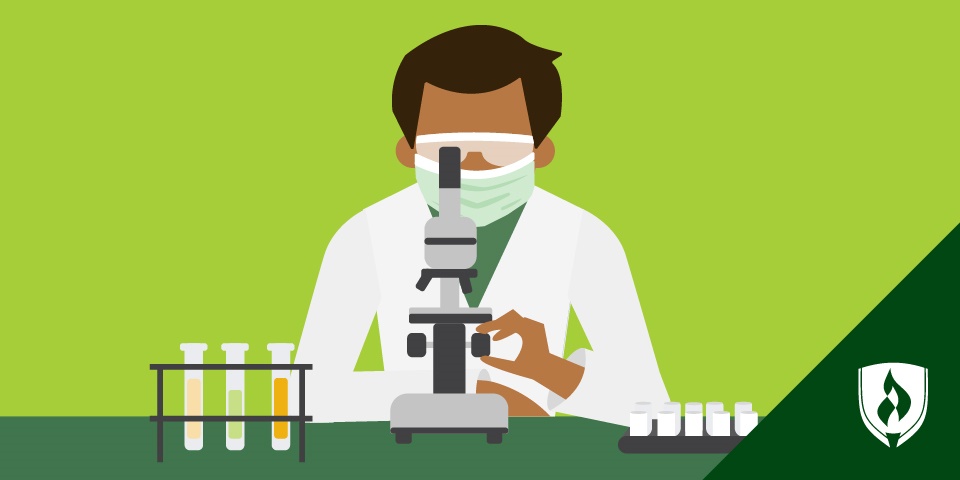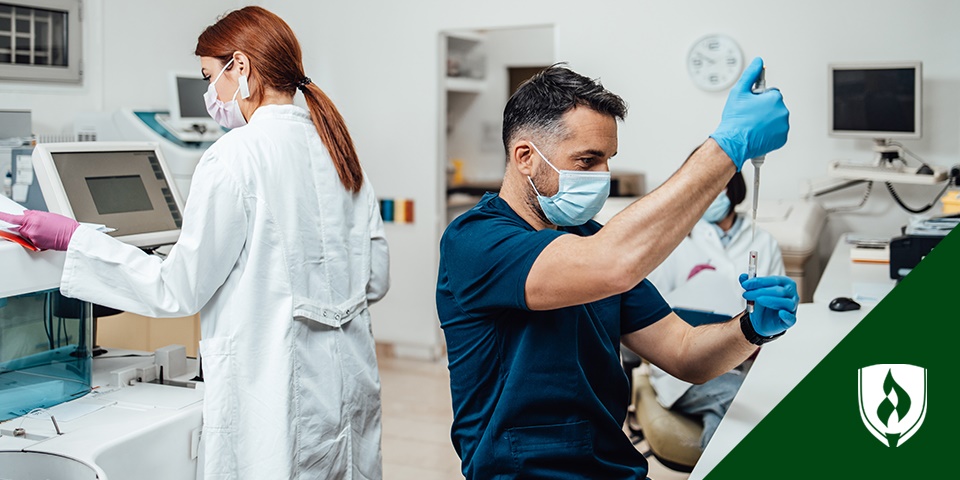
We all see our fair share of nurses, doctors and medical assistants when we go in for routine check-ups. But we rarely see what happens to our blood sample after it is carted away.
The professionals behind the curtain are responsible for analyzing biological material for diseases or abnormalities. They can be called anything from a lab assistant to a medical lab technician (MLT), but they have one thing in common—they perform lab tests to help find a diagnosis.
The job may sound pretty straightforward at first, but there is actually a lot to lab work beyond beakers and test tubes. We spoke with Laurie Bjerklie, a Rasmussen College MLT program coordinator, to get the scoop on working in a lab. She uncovered seven things you may not have guessed about this behind-the-scenes healthcare career.
7 things that might surprise you about working in a lab
1. Working in a lab requires certification in many states
You’re not going to be a doctor, so you might think you’ll get a healthcare job without all that extra training. While it’s true that you won’t need to spend years in medical school, you’ll still have to pass some tests to begin your career working in a lab.
One surprising fact for people considering lab work that examines patient specimens is the national certification requirement for most lab employment. “MLTs also need licensure in some states, requiring national certification and payment of dues,” Bjerklie explains.
2. Doctors rely on your analysis for diagnoses
Contrary to popular opinion, doctors aren’t the ones with all of the answers. In fact, more than 70 percent of physician’s decisions are based on laboratory results, according to Quest Diagnostics.
“There wouldn’t be a hospital without a lab,” Bjerklie says. “We are essential in determining patient diagnoses, patient management of their disease and therapy and screening for specific conditions. MLTs may not be hands-on directly with patients but they still have a huge impact on their journey.” She goes on to explain that providers rely on the knowledge and expertise of MLTs to provide them with quality, accurate results so they can better help their patients.
3. Practically any body fluid or tissue gets processed in a medical lab
The results are virtually endless since all types of human samples come through a lab. “Medical lab technicians analyze almost everything in the human body unseen,” Bjerklie says.
MLTs examine all types of samples, but the bulk of their work can be broken down to the following:
- MLTs analyze proteins and enzymes to see how your major organ systems are functioning (i.e., liver, heart, kidneys, pancreas and so on).
- MLTs look at your blood cells to assess if you have a bacterial or viral infection, leukemia or anemias.
- MLTs look for all four of the main microorganism areas—bacteria, fungus, parasites and viruses to determine which one of these may be causing the infection.
- MLTs are central in determining blood type and compatibility to ensure you are getting the correct transfusion products to minimize dangerous reactions.
4. Working in a lab means every day is a surprise
Any healthcare job is a little unpredictable. Just like a nurse never knows who’s going to come through the doors of the emergency room, you truly never know what kind of specimen will come through your lab window.
“MLTs have a variety of work to do every day. You can work in multiple departments or choose to specialize in one,” Bjerklie says. “There are lots of opportunities and it never gets dull.”
5. Laboratory support is in demand
MLTs hold one of the most in-demand positions in the healthcare industry. MLT jobs are projected to grow 13 percent through 2026, according to the Bureau of Labor Statistics. This is nearly double the national average of 7 percent for all occupations.
As promising the outlook is, employers are still struggling to find qualified candidates to fill MLT positions. In fact, technicians were listed in Forbes’ 2016 Hardest Jobs to Fill. But why?
“There is a large amount of retirements occurring in our field and very few MLTs to replace them,” Bjerklie explains. “Because we work behind the scenes in the hospital, a lot of people don’t know our field exists or the extent of what we truly do.”
6. Working in a lab is less stressful but still very hands-on
There’s no doubt that some healthcare jobs, particularly in direct patient care positions, are stressful—considering the matter of life or death and making split-second decisions. Fortunately, MLTs don’t have to endure intense work environments like their patient-facing counterparts. In fact, MLTs have even been dubbed one of the least stressful careers.
“You work behind the scenes while still being very hands-on,” Bjerklie says. “MLTs perform a very crucial role in patient care and diagnoses, but it is also a great work environment that can be fun.”
7. You can enter the field in less than 2 years*
Job growth and career advancement can be a concern for any industry. Advancement to a managerial position working in a medical lab typically requires a four-year degree, according to the BLS.
But what you may not know is that you don’t need to spend several years in school to prepare. In fact, you can get your foot in the door and start your exciting career in as few as 21 months by earning an associate's degree.*
“A two-year associate's degree is a great place to begin,” Bjerklie says. After learning the core curriculum and acquiring hands-on experience, she says you can enter into the workplace. “Once you are graduated and working, there are several options out there to allow you to gain that Bachelor’s degree when you are ready,” she adds.
To sum it up…
When it comes to healthcare, working in a lab is an exciting option. There is a lot more to the job than meets the eye, including the opportunity to play a vital role in helping patients without all of the stress that comes with other direct-care positions.
Do you think you have what it takes to land a career working in a lab? Find out in our article, 6 Signs a Medical Lab Tech Career is Right for You.
*Time to complete is dependent on accepted transfer credits and courses completed each quarter.
EDITOR'S NOTE: This article was originally published in March 2014. It has since been updated to include information relevant to 2017.
RELATED ARTICLE:




